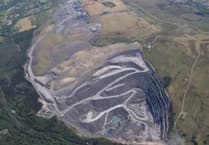In a remarkable discovery, one of the world's most important fossil deposits has been found in Powys.
A large number of extraordinary new fossils, including many soft-bodied creatures, have been discovered near Llandrindod Wells. Amgueddfa Cymru – Museum Wales researchers found the fossils in rocks which were laid down under the sea over 460 million years ago, a time when what is now Mid Wales was covered by an ocean.
An article published this week in the journal Nature Ecology and Evolution describes the fauna of over 170 species from a new fossil site, known as Castle Bank, dating from the Ordovician period. This site was discovered during the COVID-19 lockdowns by independent researchers and Llandrindod residents Dr Joseph Botting and Dr Lucy Muir, Honorary Research Fellows at Amgueddfa Cymru. They worked with other researchers in Amgueddfa Cymru, Cambridge, Uppsala (Sweden) and Nanjing (China) to bring the news to the world.

The fossil deposit is included in the “Burgess Shale-type faunas”, a celebrated type of fossil preservation where soft tissues are fossilized as films of carbon in mudstone. Almost all the previous examples are from the Cambrian Period (when animals with skeletons appeared in the fossil record), but Castle Bank dates from the Middle Ordovician, some 50 million years later. This is important, because it gives us a new window into how life was evolving at this time.
As Dr Muir explains: “It coincides with the 'Great Ordovician Biodiversification Event', when animals with hard skeletons were evolving rapidly. For the first time, we will be able to see what the rest of the ecosystem was doing as well.”
Fossils of many different kinds of animals were found at Castle Bank. Most of the animals were small (1-5 mm) and many were either completely soft-bodied when alive or had a tough skin or exoskeleton. Places where such soft-bodied fossils are found are extremely rare, and only one other Ordovician site in the World (the Fezouata Biota of Morocco) preserves close to this level of detail. Such sites give us an important glimpse of the full variety of life in the past, not just the animals with hard shells and bones that are usually found as fossils.
The Castle Bank fossils include the youngest known examples of some unusual groups of animals, including ‘opabiniids’ with their vacuum cleaner-like proboscis, and ‘wiwaxiids’, strange oval-shaped molluscs with a soft underbelly and a back covered with rows of leaf-shaped scales and long spines [Unusual new fossils from ancient rocks in Wales | Museum Wales].
At the same time, the site also includes the oldest examples of more modern-looking animals, including an animal that looks almost like an insect and may be distantly related to them. The new fossils also include many different types of worms, sponges, barnacles, starfish and a primitive ‘horseshoe crab’.
Very fine details can be seen on many of the fossils under the microscope, including eyes and possible primitive brain in the head of an unknown arthropod, gut traces in trilobites and other animals, and worm tentacles and jaws. Researchers in Sweden also dissolved some of the rock in hydrofluoric acid, and extracted minute fragments of organic remains that show cellular-level detail.
Despite the extraordinary range of fossils already discovered, work has barely begun, says Dr Botting. “Every time we go back, we find something new, and sometimes it's something truly extraordinary. There are a lot of unanswered questions, and this site is going to keep producing new discoveries for decades. This is just the beginning, and we're excited to see what comes next!”

.jpg?width=209&height=140&crop=209:145,smart&quality=75)



Comments
This article has no comments yet. Be the first to leave a comment.